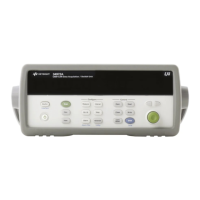7Tutorial
276 Keysight 34970A/34972A User’s Guide
Measurement Fundamentals
This section explains how the 34970A/34972A makes measurements and
discusses the most common sources of error related to these measurements.
The Internal DMM
The internal DMM provides a universal input front-end for measuring a variety of
transducer types without the need for additional external signal conditioning. The
internal DMM includes signal conditioning, amplification (or attenuation), and a
high resolution (up to 22 bits) analog-to-digital converter. A simplified diagram of
the internal DMM is shown below. For complete details on the operation of the
internal DMM, refer to “Measurement Input” on page 90.
The internal DMM can directly make the following types of measurements. Each of
these measurements is described in the following sections of this chapter.
– Temperature (thermocouple, RTD, and thermistor)
– Voltage (dc and AC up to 300V)
– Resistance (2-wire and 4-wire up to 100 MΩ)
– Current (dc and AC up to 1A)
– Frequency and Period (up to 300 kHz)
Rejecting Power-Line Noise Voltages
A desirable characteristic of an integrating analog-to-digital (A/D) converter is its
ability to reject spurious signals. Integrating techniques reject power-line related
noise present with DC signals on the input. This is called normal mode rejection or
NMR. Normal mode noise rejection is achieved when the internal DMM measures
the average of the input by “integrating” it over a fixed period. If you set the
integration time to a whole number of power line cycles (PLCs) of the spurious
input, these errors (and their harmonics) will average out to approximately zero.
To/From
Earth
Referenced
Section
= Optical Isolators
Amp
Signal
Conditioning
Analog to
Digital
Converter
Main
Processor
Analog
Input
Signal

